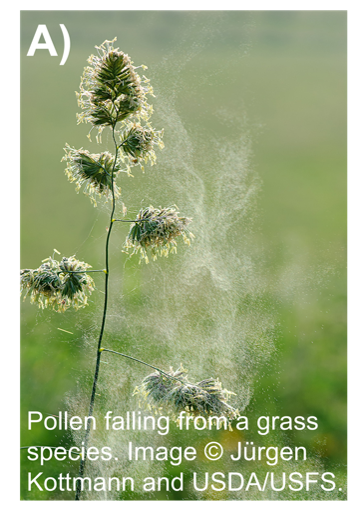
Air Quality and Climate
Climate change will bring warmer temperatures and changes in rain and snowfall. These shifts in weather affect us in many ways, including the air that we breathe. You might notice more smog and visible haze on very warm days. Heat domes forming in cities prevent cool breezes from carrying away pollution.
For example, when temperatures are warmer, ground-level ozone pollution is higher. This is likely to get worse with climate change. It doesn’t stop there! Ground-level ozone is a greenhouse gas, and traps heat on the earth’s surface, making it feel even warmer! Ozone can harm animals and plants, big and small. Check out our post about Air Quality, Animals, and Plants for more information!
You (and your nose) might notice pollen in the air from grasses, trees, and other plants during the spring. Spring pine pollen forms a thick coating on surfaces – from sidewalks to cars to houses! Pollen is part of our air quality. With warmer temperatures, the pollen season is both longer and more intense. For example, ragweed pollen season lengthened by 6 – 25 days across the US between 1990 and 2015. NADP’s Aeroallergen Monitoring Science Committee (AMSC) monitors these aeroallergens, such as pollen. Next time you sneeze, think about climate change. You can check out more about aeroallergens in our post on Asthma and Pollen.
Larger wildfires are more common with warmer temperatures and less rain. Wildfires release smoke, which can make air quality worse for days to weeks after a nearby fire. Wildfire smoke contains gases, small particles, and water. NADP monitors deposition every day of the year, including wildfire season. Check out our post on Wildland Fires and Smoke.

RESOURCES:
EPA’s Climate Change Impacts on Air Quality: https://www.epa.gov/climateimpacts/climate-change-impacts-air-quality
National Center for Atmospheric Research’s Ozone Garden Network: https://www2.cgd.ucar.edu/research/ozone-garden/
NOAA’s Wildfire climate connection: https://www.noaa.gov/noaa-wildfire/wildfire-climate-connection
USDA’s USFS Smoke and Air Quality: https://www.fs.usda.gov/research/fire/smoke
EPA’s Wildfire and Indoor Air Quality: https://www.epa.gov/indoor-air-quality-iaq/wildfires-and-indoor-air-quality-iaq
Fifth National Climate Assessment Air Quality: https://nca2023.globalchange.gov/chapter/14/#key-message-4
SAMPLE SOCIAL MEDIA POST:
Which of the four photos likely has the best air quality? Warmer temperatures from climate change can lead to longer and more intense pollen in the spring, bigger and more frequent wildfires, and higher levels of smog and haze.
There are four pictures in the post.
- Pollen falling from grass species – photo © Jürgen Kottmann and USDA USFS
- Interceptor Fire near Big Cypress National Park – photo by NPS
- People hiking in Olympic National Park with a clear sky – photo by NPS
- A white haze caused by pollution in Great Smoky Mountains National Park – photo by NPS
Answer: C) People hiking in a park with a clear sky.
Tags: #AQAW #NADP #airquality #climatechange #pollen #ozone #wildfire




